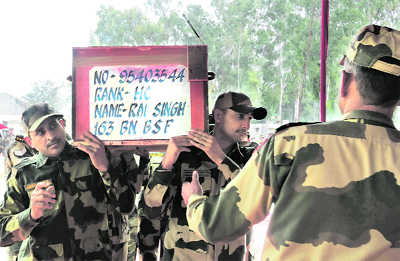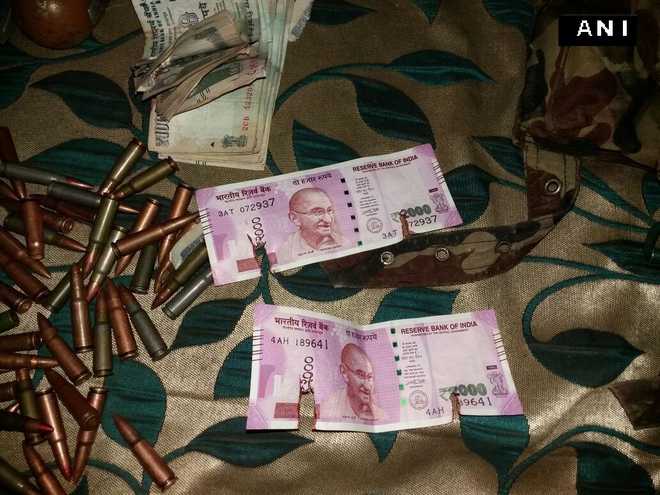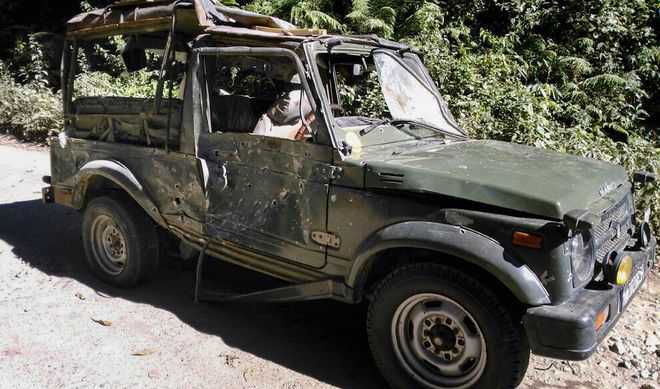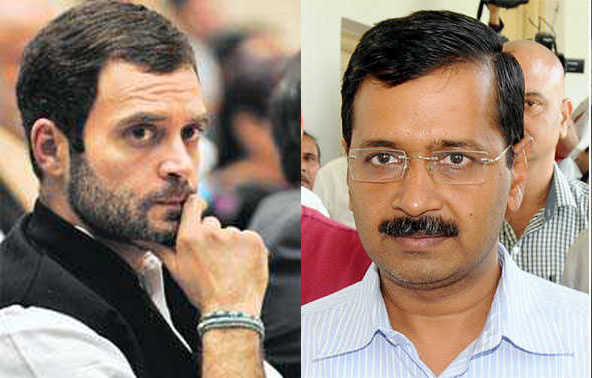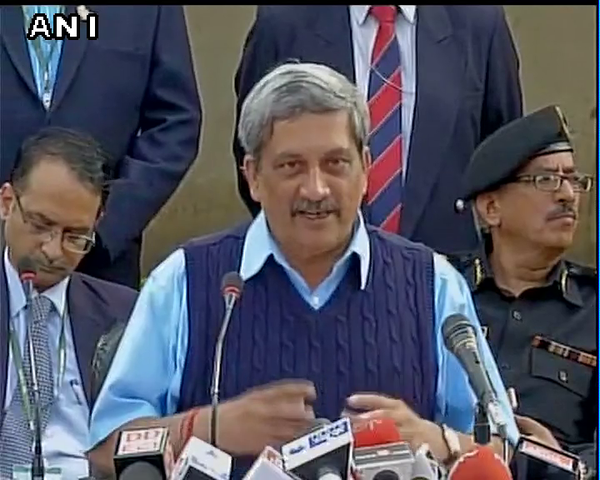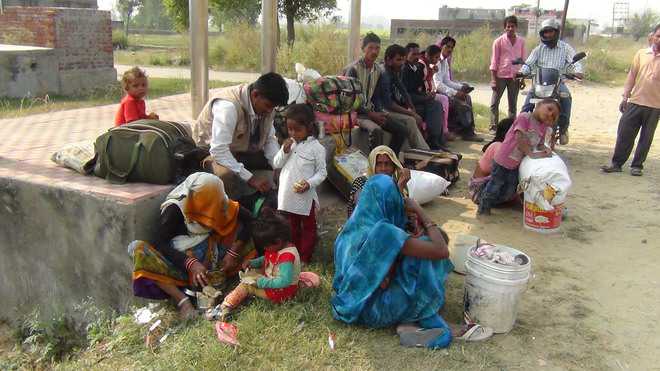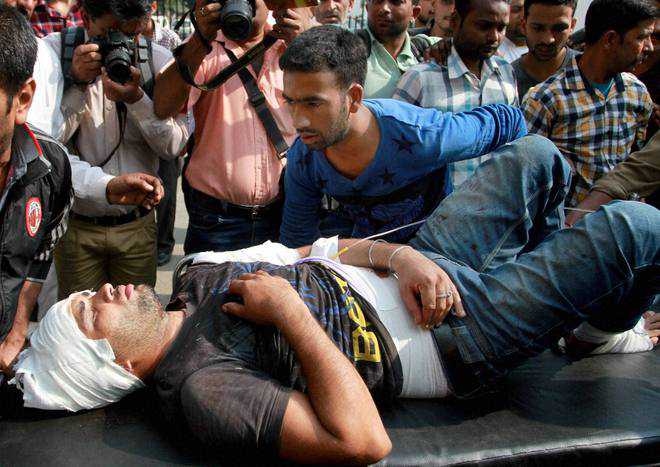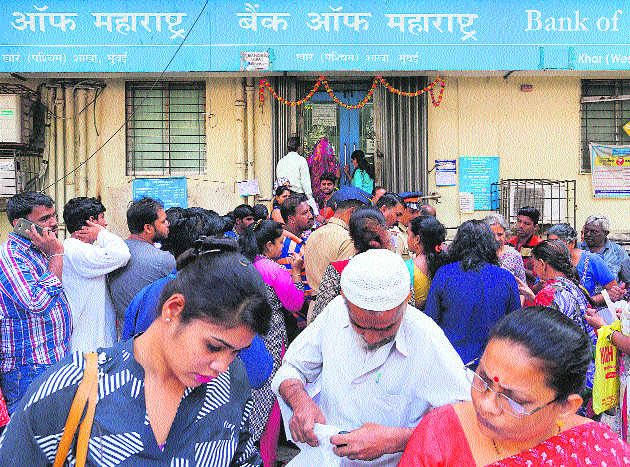 A run for money: Long queues and longer wait have added to the chaos.
A run for money: Long queues and longer wait have added to the chaos.THE demonetisation programme is a classic case of a good idea that is poorly executed. The long lines of people snaking in front of banks across the country seeking to withdraw small amounts of money is testimony to the fact that the withdrawal of Rs 500 and Rs 1,000 notes has created tremendous hardship for the common man. Clearly, the government did not anticipate this level of demand for currency notes in the first few weeks of the scheme. While it is being stated that new currency notes were being printed over the past few months, it is evident that the logistical issues of transporting these notes to the banks and ATMs had not been worked out efficiently. The other technological issue of sensors needing to be changed in the ATMs also needed to have been considered while formulating plans for changeover to the new notes. Surely, in a country renowned as an IT superpower, it should have been possible to get the right advice to ensure that this technological roadblock was quickly overcome. The net result is that instead of discussing various aspects of the demonetisation policy, as was originally planned for this article, one has to comment on the mess created by poor implementation. Any policy that can conceivably lead to the loss of human life should be carried out with extreme care. In this case, persons who require medical assistance from private medical practitioners and institutions have no recourse. It is not enough to say that government hospitals will accept old notes as these institutions do not meet the entire health needs of the people. A special facility should have been created for those facing medical emergencies who have to go to private clinics and hospitals. Human lives need to be valued more highly in this country than has been done till now.One can only hope that the current state of chaos resolves earlier rather than later. And that the general public, especially those living in remote areas where banking facilities are non-existent, are able to recover from the economic setback speedily.As for demonetisation itself, there is no dearth of skeptics but the fact is that it is bound to make a dent in the parallel economy. Data shows that the share of Rs 500 and Rs 1,000 notes in total currency notes has been disproportionately high. The value of 500 notes had reached 47.8 per cent and Rs 1,000 notes had touched 38.6 per cent of the total currency value in circulation, as of March this year. In contrast, Rs 100 notes also comprised 9.6 per cent of the total currency. The rate of increase in the higher value notes has also been at over 30 per cent over the last decade while Rs 100 notes have remained at virtually the same level.It is being argued that the wealth in the parallel economy is being stashed away in other assets like gold or real estate, rather than in hard currency. The fact is that even the World Bank has estimated that one fourth of the Rs 14.6 trillion currency in circulation forms part of this parallel economy. It also forms a big part of the election process. Political parties who have been shying away from laws banning cash donations or ensuring transparency in cheque payments, have blatantly used money power in elections over the years. This is borne out by a recent comment by a former election commissioner who has lauded the demonetisation measure citing the huge movement of currency in states where elections are about to be held. No wonder then that many are accusing the government of trying to create problems for political parties gearing up to face elections in Uttar Pradesh. Social media messages abound, alleging that the BJP has taken care of its own currency needs before taking this decision. As far as the real estate sector is concerned, the stock market reeled after the announcement and share prices fell by 12.5 per cent, a clear indication that hard currency plays a significant role here. Much of the discourse over real estate implies that unaccounted funds are parked in land and buildings so hard cash is not really the issue. On the contrary, any real estate transaction involves from 20 to 50 per cent hard currency. It is extremely difficult to buy or sell property in this country without getting sucked into the parallel economy. Real estate agents often tell prospective clients that prices will be substantially lower if they opt for an ‘all white’ deal. Similarly, currency plays a huge role in jewellery transactions. Customers with bundles of cash are a common sight in jewellery showrooms.No doubt efforts have been made after demonetisation to convert hoarded cash troves into other assets like gold and real estate. Besides, a black market has also sprung up for Rs 500 and Rs 1,000 notes, creating yet another facet of the illegal economy. So it will not be correct to say that demonetisation has flushed all the illegal money out of the system. Even so, a large chunk of the black currency in circulation will still be redirected to the banking system or else be rendered useless. The increased funds will improve government revenues substantially.Reducing the element of counterfeit currency has been another reason for this step. But it may not be the major cause as this can be dealt with by introducing more security measures in notes.The question now is, will demonetisation yield the desired results. The parallel economy will not be wiped out overnight by this measure. But some headway will have been made. What is more important is that measures are taken to ensure that currency no longer becomes easy to use as part of the black economy in future. The blame is being put on lax policies in the past which led to the gradual growth of this gigantic parallel economy. Taxation polices need to be structured to incentivise greater compliance. The new GST is likely to be a major element in any such change as it aims at making tax paying easier for citizens. Other measures are said to be in the offing. One can only wait for these to be unveiled and also hope that after all the hardships faced by the common man, demonetisation leads to a cleansing of the entire financial system in the long run.
Feel the aam aadmi’s pain…or pay for it
Surendra Kumar
To call the harassment of the aam aadmi , as a result of demonetisation, just a minor inconvenience betrays callousness. The Finance Ministry underestimated the disruption to lives of ordinary people. The capability of banks, manpower and ATMs to address the citizens’ needs was overestimated.
 YOU CANNOT BANK ON THEM: As people queue up to exchange old RS 500 and Rs 1000 notes, their patience wears thin. A lot of time of the bank employees is spent in addressing bureaucratic requirements for the measly sum of money they can dispense. PTI
YOU CANNOT BANK ON THEM: As people queue up to exchange old RS 500 and Rs 1000 notes, their patience wears thin. A lot of time of the bank employees is spent in addressing bureaucratic requirements for the measly sum of money they can dispense. PTIPRIME MINISTER Narendra Modi’s announcement on November 8 that the currency notes of Rs 500 and Rs 1000 will cease to be legal tender from midnight was a bold and imaginative masterstroke. It will deal a crushing blow to the generation and circulation of the black money, funding of terror by induction of fake currency notes and the way political parties fund their activities, especially election campaigns. In the long run, it should impede the ill-effects of the parallel economy and bring large amounts of black money into circulation in the form of white money and facilitate numerous development plans. The government agencies involved also deserve kudos for maintaining absolute secrecy, like the nuclear tests in May 1998, and taking hoarders of black money by surprise. It’s a welcome step which ought to be applauded and supported by all conscientious citizens. Look at it from the perspective of ordinary citizens — who are neither generators of black money nor hoarders — who go about their uneventful daily lives with paltry sums of money in their hands to buy basic necessities. These necessities are requirements for children’s school, cooking oil, rice, wheat flour, sugar, bread, milk, eggs, pulses, vegetables and medicines etc. Then there are small farmers in need of seeds, fertilisers and daily-wage earners who somehow eke out a living. The execution of the brilliant idea has been a disaster. The simple, unexciting lives of these people have been turned upside down; their work and daily chores have been completely disrupted. This has filled them up with anger, bitterness and frustration, even though they support the Prime Minister’s decision in principle.Leaders and officers who are claiming that the implementation has caused only a minor inconvenience are telling blatant lies. They are living in their ivory towers, cut off from the distress at the grass-roots level. None of the ministers or secretaries or leaders has stood in a queue for eight hours to exchange just Rs 4000. None of them has gone back without getting the new notes and returned to join the queue the following day in hope of better luck! Calling citizens’ harrowing experiences a small inconvenience betrays insensitivity and callousness towards the common man’s plight; it is an insult. Those who are painting a rosy picture and are dismissive of hardships being endured by millions of people all over India are misinforming the Prime Minister about the public’s true feelings. The Finance Minister’s remarks that it will take two to three weeks more to calibrate all the ATMs to disburse new currency notes is bad news; it might further test the aam aadmi’s patience.In the late 1970s, none could disagree that population control was in India’s national interest and deserved to be undertaken nationwide on priority as, in terms of population, we were adding one Australia every year. In medical terms, nasbandi was an inexpensive and effective family planning option. However, the overzealous and insensitive implementation of a sensible initiative antagonised millions of ordinary people who handed to Indira Gandhi and her son Sanjay the most humiliating defeat and voted the Congress Party out of power. Given, the demonetisation decision and nasbandi operations can’t be compared and we are living in totally different times. But, one factor is common; people surrounding Indira Gandhi, both from the party and the government, insulated her from the negative reaction and disenchantment; they were simply singing praises about the success of family planning operations. Surprisingly, the same is happening today; the government and the party are insulating Modi from adverse and critical reports. Apparently, the Finance Ministry grossly underestimated the inconveniences and disruption to normal lives of ordinary people and highly overestimated the capability of infrastructure: banks, manpower and ATMs to address the needs of millions of harassed citizens. If the situation continues for two to three weeks more, it might produce unexpected consequences for the ruling party. Millions of the unhappy and frustrated Indians might do a Brexit for the ruling party in the coming state elections.One of the Parkins’ Laws says: “Work expands according to the time available.” A lot time of the banks is being spent in addressing bureaucratic requirements for the disbursement of a measly sum of Rs 4000. One has to fill in a form which requires information about one’s name, address, ID proof, number of currency notes being surrendered and the contact phone number. This makes one feel as if one is buying foreign exchange at the airport. Why not raise the limit to Rs 10,000 and give the new notes on production of an ID card? The man/woman standing in the queue for eight hours isn’t a terrorist or a dealer in fake currency.In big cities like Delhi, millions of menial wage earners work on roads, streets, construction sites and other unorganised sectors and possess no ID proof. They too are human beings. They should be given new currency notes to survive on the basis of a one-line certificate from their employer/hirer of their services. Rs 4,000 is too small an amount for a serious medical treatment; this ceiling should be raised up to Rs 20,000 and both the government and private hospitals must accept this payment in old currency notes till the end of December 2016. As Arvind Kejriwal, the Delhi Chief Minister, is prone to making wild allegations, there are very few takers for his new allegation about the BJP supporters having been tipped off in advance about the impending demonetisation. But one does wonder why the BJP functionaries sound so nonchalant and tension free about the after-effects of this “surgical strike. “After all, like their rivals, they too have been using black money for their candidates. In the forthcoming Asembly elections in Punjab and Uttar Pradesh, are they going to pay their candidates/workers through credit cards and cheques? Likely? Amen!The writer is a former Indian Ambassador to Libya.






















































